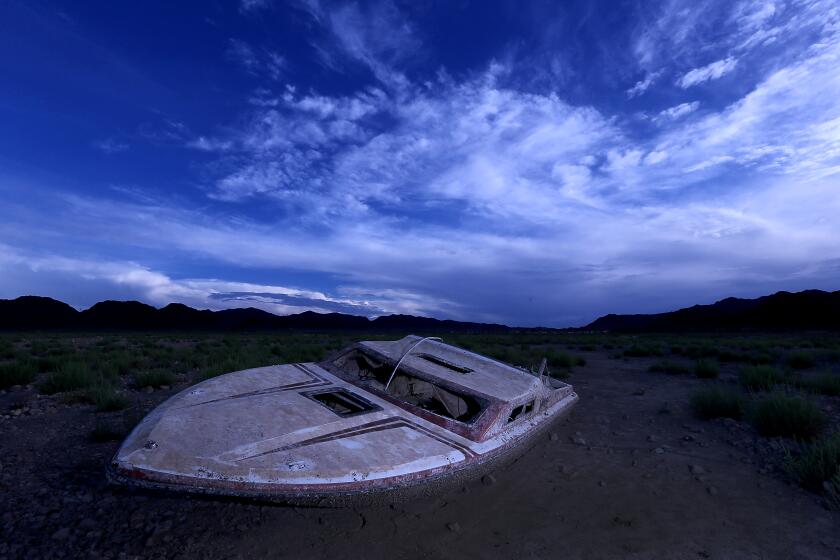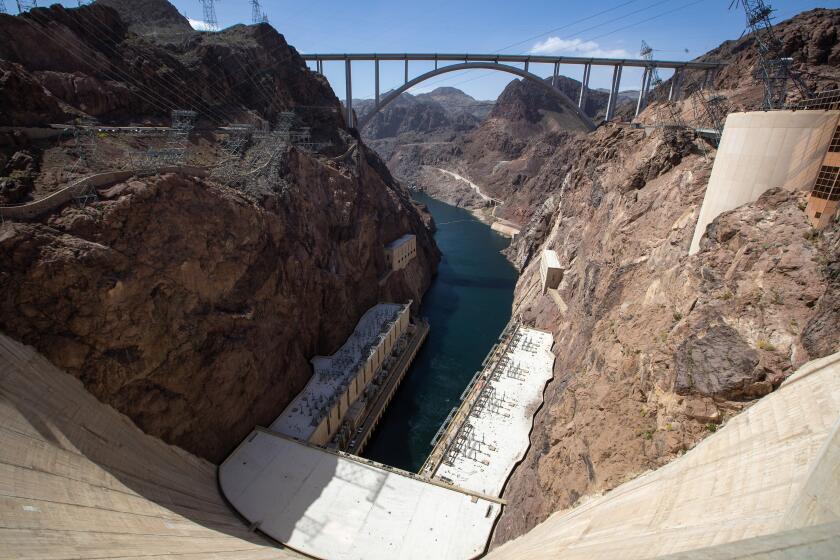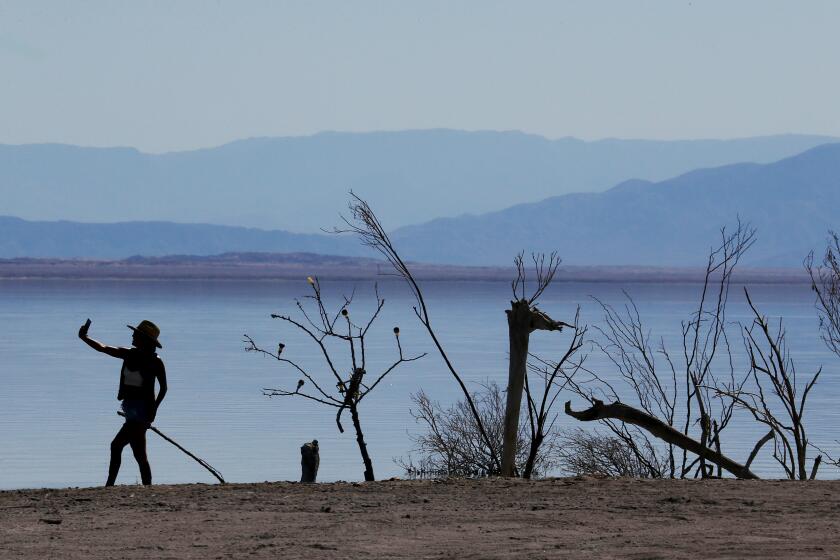Running and cycling to raise awareness of global water issues
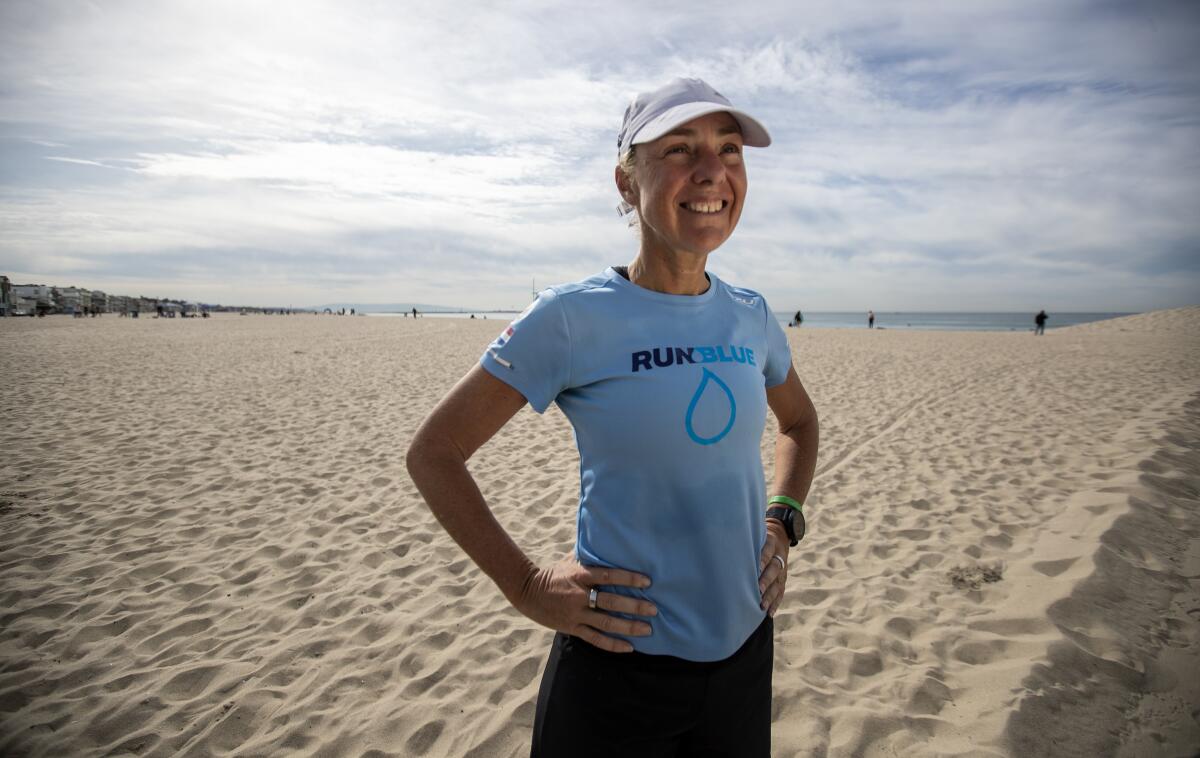
- Share via
Over the past year, Mina Guli has run marathons in 32 countries from Australia to Zambia. She ran through cities and farmlands in California, and along the shores of the largest reservoirs in the American West.
All of her runs have had a guiding purpose: to call attention to global water issues.
Guli, a 52-year-old Australian, has battled injuries along the way, including a bruised hip at the Dead Sea in Jordan, along with hamstring issues and a painful shin. But she said she kept her mind set on her goal of completing 200 marathons in a year — and during each run, she stayed focused on the next stretch, the next step.
“I’m doing this because I want to raise awareness of the water crisis. I want to show the urgency of the problem that we’re facing,” Guli said. “I want to show that we are capable of doing the hard things that are necessary for us to be able to achieve this change, whether it’s running 200 marathons or solving the global water crisis.”
Guli recently finished her yearlong series of runs at the United Nations headquarters in New York, where thousands were attending a U.N. water conference. She called for action to address the struggles of people around the world facing “too little water, too much water or too dirty water.”
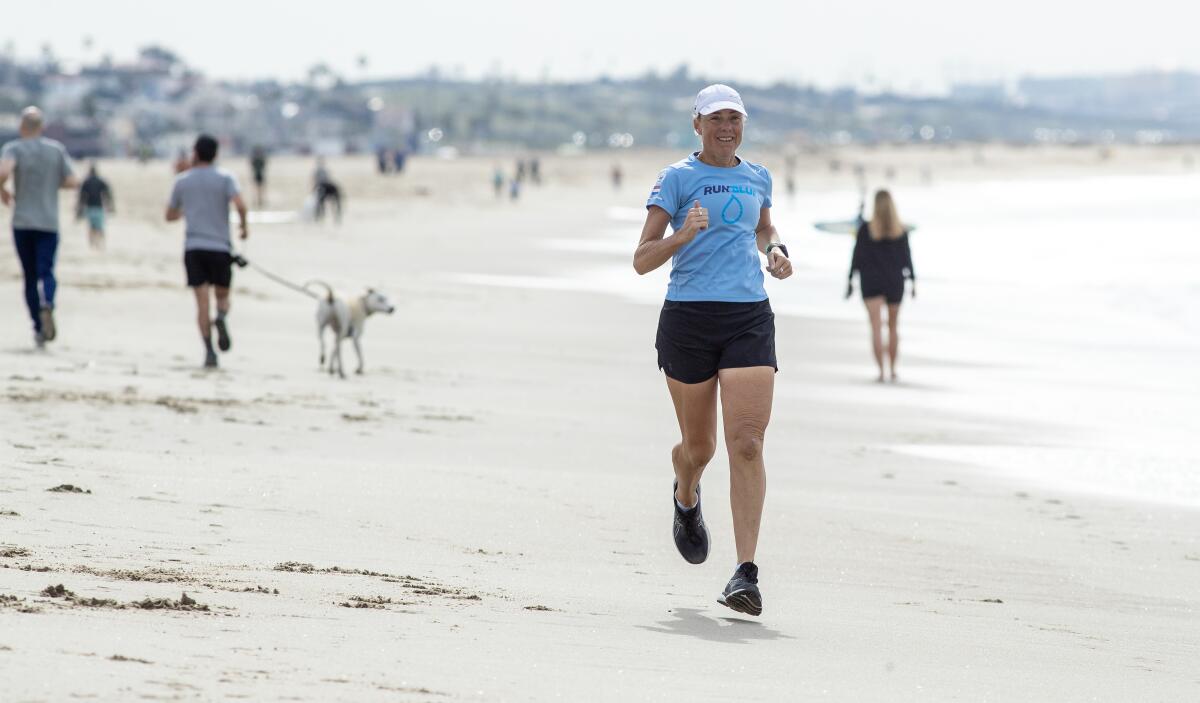
Guli’s activism as founder of the nonprofit Thirst Foundation has encouraged others to take part by running through a global campaign called Run Blue.
It’s one of multiple efforts that have emerged using athletic pursuits to raise awareness about water, whether through running, cycling or other types of journeys.
During Guli’s recent runs in Southern California, a separate group of water researchers was cycling nearby, exploring the Salton Sea and the Colorado River.
Guli, who previously worked as a lawyer and ran an investment fund, started her nonprofit in 2012, seeking to promote action to protect water resources.
The United Nations held its first water conference in decades, focusing on crises and solutions. The U.N. chief said ‘water is in deep trouble’ globally.
Over the past year, she planned her latest series of runs in water-stressed regions, saying she wanted to go to the “front lines of the water crisis.”
She ran in Kenya, Tanzania and Malawi. And Bolivia, Brazil, India, Mexico, Peru, Spain and Vietnam, among other countries.
She met with people on the desiccated shores of the Aral Sea in Uzbekistan and saw fishing boats abandoned on the dry bed of what was once Bolivia’s Lake Poopó.
“It’s devastating to see yet another lake that has dried up in the last decade due to climate change and overuse,” Guli said in a video in Bolivia. “We need to tackle water challenges before they become crises.”
Guli advocates for protecting healthy ecosystems from forests to wetlands, curbing chronic overuse of water, and taking actions to become resilient to climate change. She also has focused on calling for solutions for people around the world who lack access to clean water.
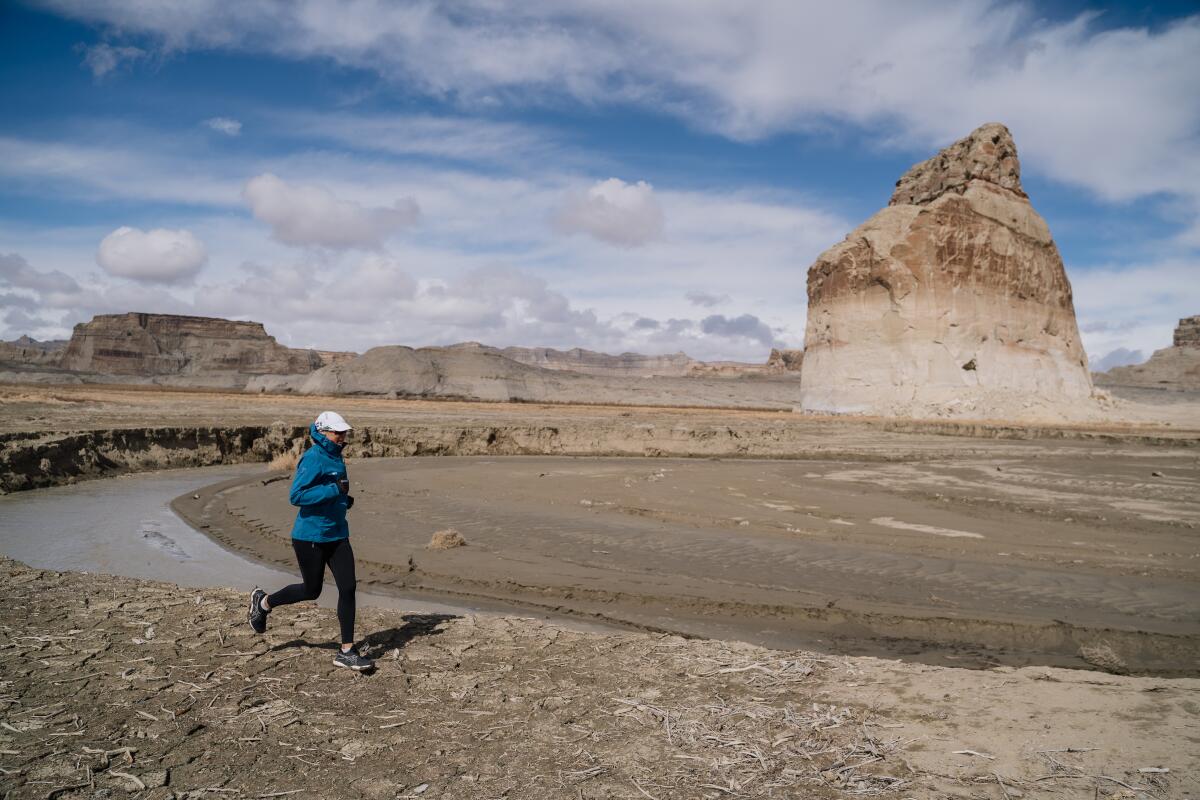
In February, she came to California, running in areas from the Russian River to the Central Valley. She met with farmers, touched the trunks of giant Sequoias and ran on Venice Beach.
When she saw sprinklers spraying lawns in the middle of the day, Guli said, she thought it showed that many people still aren’t fully aware of the need to adapt to water scarcity.
“How do we get more people to realize the value of water?” she said. “How do we get them to understand that water is fundamental to absolutely everything to do with their way of life?”
Guli calls it a problem of “water blindness.”
“Climate change is water change,” Guli said. “We just need to do things better and smarter. We need to wake up to the challenge that we’ve got in front of us.”
Turning to the over-tapped Colorado River, Guli ran marathons at Lake Mead and Lake Powell, which over the past year declined to the lowest levels since they were filled.
Seeing Lake Mead at just 28% of full capacity after 23 years of drought, Guli said she felt “to some extent frustration and anger that we’ve allowed this to even happen.”
“It is shocking, absolutely shocking, to see the catastrophe that is this river,” Guli said.
Colorado River in Crisis is a series of stories, videos and podcasts in which Los Angeles Times journalists travel throughout the river’s watershed, from the headwaters in the Rocky Mountains to the river’s dry delta in Mexico.
Running at Lake Powell near the Utah-Arizona border, Guli fought gusty winds, a dust storm and falling snow.
She ran on the dry lakebed to Lone Rock, which was once an island in the reservoir, and where people used to boat and waterski.
Looking up at the towering rock, Guli said, “I felt so small in the face of the enormity of this entire crisis.”
“This is not just an environmental problem. This is a social and economic problem as well,” Guli said.
Guli ran through farmlands in the Imperial Valley, where the largest share of Colorado River water is used to grow crops ranging from alfalfa to salad greens. Seeing water flowing in canals to the fields, Guli said she thought about how there is “a lot more opportunity to create a more efficient system.”
Heavy snow was falling in California and much of the West during Guli’s visit. She said she felt pleased seeing snow on the mountains near Las Vegas but also concerned that people shouldn’t forget the urgency of finding long-term solutions to address the water scarcity problem.
“We still need the same level of change as we did before the snows,” Guli said.
While Guli continued her runs, others recently organized different water-focused journeys.
The long-depleted Colorado River is getting a boost from the largest snowpack since 1997. Rising reservoirs offer some relief amid talks on needed water cuts.
Dustin Garrick, an associate professor of water and development policy at the University of Waterloo in Ontario, Canada, has started an initiative called Water Cycles Expeditions and recently led a group on a five-day cycling trip in Southern California and Arizona.
The journey took riders from Joshua Tree to the Coachella Valley, and beside the Salton Sea, which is fed by water draining off farmlands. The cyclists also rode next to the U.S.-Mexico border, stopping to see the area where the last of the Colorado River dries up in the desert, becoming a sandy riverbed fringed with vegetation.
“It was really a profound experience,” Garrick said.
Bicycles allow people “to get on the ground and get close to the issues,” he said. He values that perspective as a water researcher, and believes it also helps those who are interested in learning about water sources and challenges.
“The bike brings what I call the bike’s eye view,” he said.
Isabel Jorgensen, a doctoral researcher at the University of Waterloo who grew up in Southern California, said pedaling by the Salton Sea “offered a slower pace to really examine the landscape, both natural and human.”
Jorgensen studies saline lakes, among them the Salton Sea. She said being on a bike helped her notice the shift in desert vegetation as they descended toward the Salton Sea and also gave her a closeup view of Slab City, where people have erected makeshift homes near the lake.
She said cycling provided a different perspective than by car, in part because the group rode into strong winds and dust.
“The sheer force of the wind on the high wind days was knocking our bikes back and even out from under us,” Jorgensen said. “It blew dust everywhere.”
The Salton Sea has been shrinking and growing saltier, its retreating shores exposing stretches of lakebed where dust billows into the air, contributing to high rates of asthma in nearby communities.
Jorgensen said cycling enabled her to experience what it’s like for farmworkers and others who spend time outdoors near the lake.
The Biden administration has committed $250 million for projects to control dust and restore habitat around the shrinking Salton Sea.
Garrick said his initiative will involve many more cycling expeditions. He said he wants to build a global “network of water cyclists, those who are passionate about both water and cycling, and to mobilize that network to conduct citizen science, and citizen science that builds and benefits communities.”
Garrick is thinking big, with a goal of establishing a network of about 2 million water cyclists by 2025 in communities around the world, beginning along the Grand River in Canada and continuing to start community-led “citizen science hubs” in countries from the United States to Kenya.
Garrick expects that some participants will be motivated mainly to ride creative routes, while others will be interested in delving into water issues. Participation may be as simple as snapping photos of rivers and wetlands, he said, just as birders contribute to citizen science by sharing images of birds.
“The simple idea starts with using the bike to tell a story about water,” Garrick said in a trailer for a short documentary about the initiative. “I know this is going to sound crazy, but I do feel that connecting people and water through cycling can change the world.”
More than a month after Garrick’s group completed their ride along the eastern shore of the Salton Sea, another man set out on a run around the lake.
William Sinclair, 48, an endurance athlete and activist who goes by Irondad, wore a respirator to keep from breathing dust along the shore. He attached running snowshoes to his back and used them at times to avoid sinking into mudflats.
“I am really concerned with water matters in the Southwest,” he said. “I want to bring awareness to what’s happening at the Salton Sea.”
Irondad, who lives by the Salton Sea in Bombay Beach, completed the 96.3 mile run around the sea in less than 32 hours. He recorded his route and created a map showing his path with a red line.
He said he plans to run again next year to track the shoreline’s retreat.
“I’m hoping that people will do it with me,” he said.
Irondad hadn’t heard about Guli or the cyclists.
But Garrick said he admires how Guli is building awareness, and Guli said she thinks the cyclists are doing vital work taking people to “connect with their water” up close.
“The more people we have talking about water, the more movement that we have around water, the more voices that we have, the more we put water onto the top of the agenda,” Guli said. She described it as “lending our voice, lending of our feet, our bodies, to demonstrate that we are concerned about this issue.”
Thousands of people around the world signed up to join Guli by running or walking during a weeklong World Water Run in March.
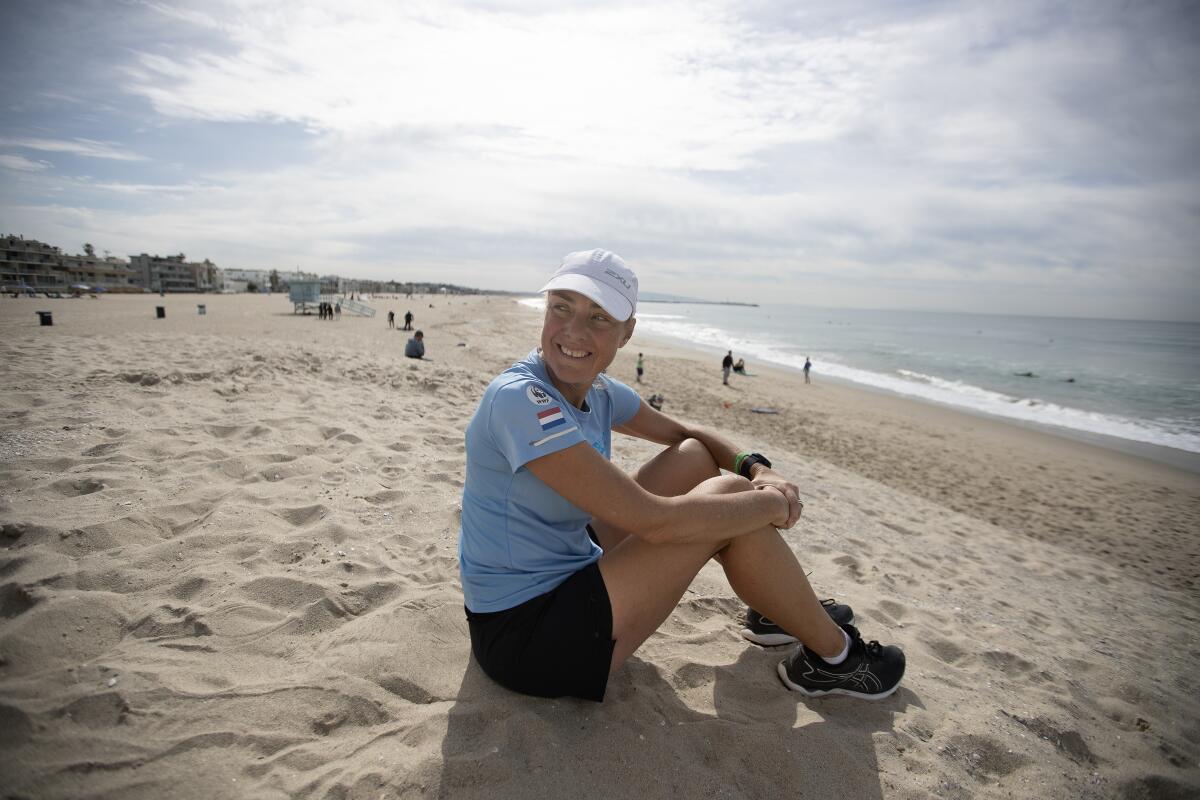
She ended her yearlong series of runs in New York with her 200th marathon on March 22, World Water Day. Outside the U.N. headquarters, she raised her arms as she crossed her finish line, surrounded by applauding supporters.
Guli said she plans to continue “spreading the message about the value of water in our lives.”
“Once we start to put water front-of-mind, and we start to make it a cornerstone of the decisions that we’re making every single day,” she said, “then we will start to actually make the change that we need.”
